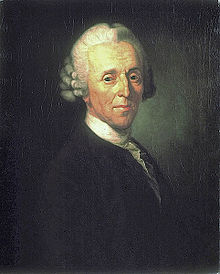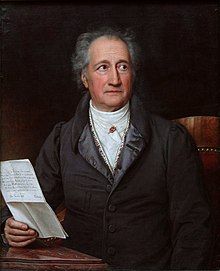Out of my life. Poetry and truth
Out of my life. Poetry and Truth is a arisings 1808-1831 book in which Johann Wolfgang von Goethe processed experiences of his life from the years 1749-1775.
Emergence
On October 11, 1809, Goethe began to design an autobiography (diaries: “Scheme of a biography”). In the last days of January 1811 the elaboration began. On June 17, 1811, he published the first book of Volume I, and on July 25, the second and third. On October 4, 1812, the end of Volume II was put into print. Volume III appeared four weeks before Easter 1814 (diaries and annuals). On April 8, 1813 at the latest, Goethe made the decision to put the work on the biography on hold (unprinted preface to Volume III) so as not to annoy living people (letter to Eichstädt of January 29, 1815; conversation with Boisseree on January 3, 1815). October 1815). News about the continuation of Volume IV can be found in the years 1816, 1817, 1821, 1824 and 1825. Goethe's final editing of Volume IV did not begin until November 9, 1830. Volume IV (= fourth part, book sixteen to twenty, 195 pages) appeared in Goethe's works in 1833 after Goethe's death . Complete edition last hand .
As a reason for writing a life story, Goethe refers in the preface to numerous questions about how a single person could write so many and so different works. With the book he would like to explain the person behind it, their development and the background to the versatility of his writings.
content
Childhood and youth

Goethe dedicates the first chapter to his childhood in Frankfurt am Main , whereby the fate of his father, his schooling, the French occupation of Frankfurt during the Seven Years' War and the close relationship with his sister Cornelia Schlosser are formative for this time. He is tutored at home by his father and partly by the private tutor, mainly in languages, both modern and dead , trying out the visual arts and discovering a talent for poetry.
Through the occupation of the French and the billeting of a king's lieutenant with the Goethes, he met merchants and painters and had direct contact with the protagonists of Frankfurt's high culture and its surroundings. He also learned French and wrote his first small plays for the theater.
In his youth, on the other hand, he came into contact with other young people and through this also met his first great love, Gretchen. The young people persuade him to introduce one of them to his grandfather, but only to commit a fraud, which ultimately leads to the exclusion of the entire group, except for Goethe, from Frankfurt and thus to the separation from Gretchen. In order to overcome this lovesickness , Goethe decides to start studying law at the other end of the country, in Leipzig .
Education

In Leipzig, he and a penniless theologian moved into a room with an old landlady and quickly realized that he was more interested in literary studies than in law, and especially in the lectures of Christian Fürchtegott Gellert . He therefore persuades his father's friend, who is supposed to watch over his training in Leipzig, to be allowed to visit it and only proves the appearance of events in law. In addition, there is drawing lessons with Adam Friedrich Oeser , which also includes many conversations that have a lasting impact on him. The studies are interrupted by a severe hemorrhage , which almost kills him, and a lump on his left neck, both of which ultimately lead to his return to his parents in Frankfurt to recover.
There he met Susanne von Klettenberg and was deeply impressed by her religiosity. He also used the time in the sick bed to look through old letters and works and destroy almost all of them. Only the mood of the lover and the accomplices remain from his time in Frankfurt and Leipzig. The relationship with his father, however, deteriorates because he considers him a sick man.
In order to be able to complete his studies and then obtain a doctorate, Goethe moved to Strasbourg after his recovery and through his father's contacts there quickly found a tutor who would prepare him for the exam. However, his lack of interest in law remained, so that he turned to his own research again, this time in the field of history . There are also close contacts with medical students, which means that he also hears some lectures in this area himself.
In addition to his studies, Goethe devotes himself to his social skills and refreshes his knowledge of ballroom dancing. In the house of the dance teacher he also meets his two daughters, falls in love with the forgiven younger one, while the older one falls in love with him and, because he does not reciprocate, curses him.
He also gets to know Johann Gottfried Herder , who has already made a name for himself while Goethe is still completely unknown. He is all the more impressed by him and describes his engaging personality and good looks in detail.
In 1771, Goethe completed his studies at the second attempt with a doctorate in Strasbourg, after this had been rejected in the first attempt.
First poetic attempts
After completing his studies, Goethe went to Darmstadt, met Johann Heinrich Merck there and was introduced to the Darmstadt district . During this time he worked on his Faust and, according to his own statements, was making good progress and finished Götz von Berlichingen . Nevertheless, Herder continues to criticize and tease him. In addition, he separates from Friederike Brion by letter, then has heartache again and tried to get over it by writing poems. The result is Wandrer's Sturmlied and the figure of Marie in the Clavigo .
In the summer he is an intern at the Imperial Court of Justice in Wetzlar , where he also writes The Sorrows of Young Werther . In Poetry and Truth, he describes an overview of possible models of the characters appearing there and refers to numerous speculations, both from the time the book was written and to discussions of the present, without, however, naming specific persons and characters. In contrast to Goetz von Berlichingen, he managed the Werther almost by himself and he was also better received by readers and publishers.
In November of the same year, after the tragic death of his friend Karl Wilhelm Jerusalem , he returned to Wetzlar again to record details and background information on what was happening around him.
breakthrough

Then he returns to Frankfurt and tells of his attempts to publish his first writings. He himself thinks a lot about the complicit , but cannot find a publisher for it. Merck should therefore support him in trying to find someone for Goetz von Berlichingen and Werther, which among other things leads to the consideration of rewriting parts of the Werther, which Merck talked him out of again. He sends it off unprocessed and the great success and public approval give it a boost.
After making some acquaintances with the higher class, such as the Weimar Hereditary Prince Karl August of Saxe-Weimar-Eisenach, he traveled to Mainz and again argued with his father, who, as a bourgeois man, rejected such contacts. In particular, his satire Gods, Heroes and Wieland reaps great enthusiasm, despite Goethe's fears. At the same time as his success he notices that he cannot profit financially to the same extent as he should actually be and blames the pirated printer Christian Friedrich Himburg for this. He also tells about Lili and their relationship that took place during this time.
Against Merck's advice, Goethe then traveled to Switzerland with Counts Christian zu Stolberg-Stolberg and Friedrich Leopold zu Stolberg-Stolberg . Merck had criticized the fact that they would distract him from the real, in which the nobility had no interest, whereas that was the real reason for Goethe's success. On the way he meets the young Duke of Saxe-Weimar in Karlsruhe and his sister Cornelia, who is now married, in Emmendingen. While he considers her unsuitable for marriage, she again advises him to separate from Lili. He then traveled to Zurich to see Johann Caspar Lavater , where he also met Jakob Ludwig Passavant .
Back in Frankfurt he meets Lili, who in turn was persuaded to part with him. In order to numb the subsequent lovesickness, he devotes himself again to writing. The Singspiel Erwin und Elmire and Egmont fall during this time . In contrast to Goetz von Berlichingen, Goethe emphasizes here that he immediately started with the main parts, which made his work easier. In addition, there is the friendship with the painters Georg Melchior Kraus and Jakob Philipp Hackert , who support him.
reception
The generic name for Goethe's work is - just like its interpretation - controversial. On the one hand, it must be seen as part of his “autobiographical project” together with parts of the theory of colors and notes on parts of his life; on the other hand, Goethe himself wrote about a fairy tale in the introduction and in other letters commenting on the work.
In addition, the general question arises to what extent one is dealing with an autobiography, i.e. a review of one's own life, when reading the text, or only with a staging of one by a writer. In the 19th century and in some descriptions it was and is read as a historical work, Gabriele Blod mentions Karl Wolfgang Becker , Ursula Wertheim , Hans Mayer , Karl Joachim Weintraub and Friedrich Kemp as examples .
In contrast, a shift in the discourse and valuation of the author and work has been observed since the 1970s, in particular as a result of new insights into anthropology and discourse theory , combined with the literary debate about the death of the author .
literature
Secondary literature
Sorted by year of publication
- Richard Friedenthal: Goethe - his life and his time. R. Piper Verlag, Munich 1963, pp. 568-571.
- Gisela Brude-Firnau In: Paul Michael Lützeler (Hrsg.), James E. McLeod (Hrsg.): Goethe's narrative. Interpretations. Stuttgart 1985, ISBN 3-15-008081-9 , pp. 319-343.
- Gero von Wilpert : Goethe-Lexikon (= Kröner's pocket edition . Volume 407). Kröner, Stuttgart 1998, ISBN 3-520-40701-9 , pp. 217-220.
- Karl Otto Conrady: Goethe - life and work. Düsseldorf and Zurich 1999, ISBN 3-538-06638-8 , pp. 859-861.
swell
- Johann Wolfgang von Goethe: From my life. Poetry and truth. 3 vols. Cotta, Stuttgart a. Tübingen 1811-1814.
- Vol. 1 Cotta, Stuttgart a. Tübingen 1811 ( digitized and full text in the German text archive )
- Vol. 2 Cotta, Stuttgart a. Tübingen 1812. ( Digitized and full text in the German text archive )
- Vol. 3 Cotta, Stuttgart a. Tübingen 1814. ( digitized and full text in the German text archive )
- Johann Wolfgang von Goethe: Poetic Works, Volume 8 . Phaidon Verlag, Essen 1999, ISBN 3-89350-448-6 , pp. 9-536.
Web links
- Out of my life. Poetry and Truth Text based on the Hamburg edition at zeno.org
- Public domain audio book Poetry and Truth by Goethe at LibriVox
Individual evidence
- ↑ Gabriele Blod, “Lebensmärchen” Goethe's poetry and truth as a poetic and poetological text, Würzburg 2003, p. 8.
- ↑ Gabriele Blod: "Lebensmärchen": Goethe's poetry and truth as a poetic and poetological text. Würzburg 2003, p. 7.
- ↑ Gabriele Blod, "Lebensmärchen" Goethe's poetry and truth as a poetic and poetological text, Würzburg 2003, p. 14.


